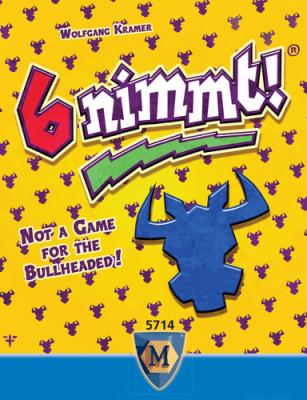
In this series of posts, Katie will be going on about some of her favourite board games and card games, and some of the interesting mathematics to be found there. If you’d like the chance to play a mathematical board game, why not find or start a Maths Arcade at university, or join your local MathsJam.
6 Nimmt! (German: Take 6!) is a card-based game which involves a hand of numbered cards, each also containing a number of cow heads. The cards are played in rounds, and during each round everyone chooses a card to play, they’re played in order, and you may find yourself having to take cards. The aim of the game is to end with the fewest cow heads.
I was given a set of 6 Nimmt! cards for my birthday a few years ago, and even though the instructions were in German, the (German) friend who’d given it to me had kindly included a printout of the rules in English. Thankfully, the rules aren’t that complicated anyway, and it’s a great game.
The cards are numbered from 1 up to 104, and each contains one or more cow heads. In the German, it’s the word ‘hornochsen’, which Google Translate tells me means ‘horn oxen’ (thanks), and Wiktionary seems to think is an offensive term for an idiot, roughly ‘bullhead’. My English translation of the rules refer to them as ‘cattle heads’. I’m told Hornochse is also the name of a burger chain in Germany. This is all probably not relevant to gameplay. Anyway, the number of cow heads on each card follows a set pattern. By comparing different cards, we established it as the following:
- all the cards have at least one cow head on them
- if the number is a multiple of five, it will have two cow heads
- if the number is a multiple of ten, it will have three cow heads
- if the number is a multiple of eleven, it will have FIVE COW HEADS. This means that while numbers like 11, 22 etc have 5 cow heads, since 55 is both a multiple of 5 and 11, it has a massive 7 cow heads.
It’s not clear why the cow heads follow this pattern, although it does give a roughly even distribution throughout the deck, and it being a fixed pattern also means you can predict which cards are going to score big in the game and try to avoid them, a little bit.
The game starts with four cards on the table, each at the start of its own row. Each player is dealt ten cards, and gameplay proceeds as follows: on each turn, everyone picks a card to play. In practise, we tend to put our chosen card on the table and keep a hand on it, so it’s clear when everyone’s picked, and then we all turn over at the same time. Whoever has the lowest number goes first, then the next lowest, and so on until everyone has played.
When playing your card, you have to place it next to one of the gradually emerging rows of cards on the table – one which ends in a card lower than the one you’re playing, but specifically, it has to also be the closest. For example, if I’m playing 26 and the rows end in 14, 25, 60 and 85, it’s larger than both the 14 and the 25, but since 25 is closer to 26, I would have to play it there. This is referred to as the ‘lowest difference’ (‘niedrigste differenz’) rule. Each player plays their card in order until everyone has played.
If your card is lower than all the cards on the ends of the four rows, you have to take a whole row. It can be any row of your choice (although the smart money is on taking the one with the fewest cards and/or cow heads) and once you take the cards, they don’t go back into your regular hand, but into a separate ‘keep’ pile, which you use to score up at the end of the game.
Many discussions have taken place about why the game is called ‘Take 6!’, if you only actually take 5 cards; I wildly speculate that the direct translation is ‘6 – take!’, which means, when there’s 6, you take, although I guess the best way to translate that into English is to call it ‘Take 5!’, which makes more sense but angers Dave Brubeck.
The other situation in which you have to take cards into your ‘keep’ pile results from the final rule, which is that no row of cards can have more than 5 cards in it – so if your card would make it six, you have to take that whole row of cards. Your sixth card is left as the new start of that row, and you take five cards. At the end of the game, when everyone has played all 10 cards from their hands, the player with the fewest cow heads in their ‘keep’ pile is the winner.
Those are all the rules of the game – each hand of 10 cards takes 10 rounds to play, so the games are fairly short; the rules suggest that you continue playing hands until someone has reached a total of 66 cow heads, although we often stop after one hand. The box lists it as being for 2-10 players (and with 104 cards, you can deal exactly 10 hands of 10 cards and leave four on the table), but with fewer than 10 there will be plenty of cards left in the box and not dealt; playing with 10 people means you can in theory keep track of which cards are still out there and try to guess who’s got them, but who has time for that?
In terms of strategy, my friends and I have yet to work out anything that’s consistently good; if there’s a card on the end of a row that’s one less than a card you’re holding, then that could be a good card to play, as nobody will be able to beat you to playing there (if they have a lower card, which means they’d play first, it will be played on a different row); the only problem might be if someone can’t play higher than any of the cards there, and swipes that whole row. This fact also means that if you have a card that’s two or three above the end card, it’s slightly riskier – if someone has the card between, they’re more likely to play it, and there’s always a chance you’ll end up being forced to play the sixth card in that row and have to take 5.
Despite being entirely number-based, there’s very little mathematical calculation to do in the game, although trying to work out your strategy is a nice challenge; I’ve played it happily with groups of mathematicians and non-mathematicians, and everyone seems to enjoy it. There’s an element of chance, as your initial hand and the cards on the table are random, and there often seems to be one unfortunate player who keeps getting forced to take loads of cards, but it doesn’t always seem to be me, so that’s fine.
It’s also very possible to make your own version of this, since all you need is a set of 104 numbered cards, and to mark the cow heads (or a penalty concept of your choice) on the appropriate cards. I’d be interested to see how distributing the cow heads differently affects the gameplay.
The game (in a yellow box, shown above) is available to buy in nerdy game shops for less than £10 (I’ve definitely seen it in Travelling Man), and it’s also on Amazon. There appear to be German and English versions available, although they’re called the same thing. I’ve also seen a Hungarian version called ‘Vigyáz(z) 6!’, a hilariously bracketed z presumably necessitated by gendered verb endings, and here the name appears to make ‘watch out for 6!’, which makes a bit more sense. More accurate Hungarian language facts welcome.
 There is also a commercially available variant of the game themed – and this is not a joke – around the TV series The Walking Dead, in which the cow heads are replaced by bullets, and all the cards have pictures of zombies on. It’s sold as ‘The Walking Dead Card Game‘, but the box acknowledges it’s the same game as 6 Nimmt!, by the same designer. There’s also some additional thematic rules, and instead of playing the usual game (known as ‘Survival Mode’) you can choose to play ‘Hero Mode’, in which the aim is to get as many bullets as possible, and you have character cards which you can play once per game giving you special powers, like getting to go first even if you haven’t got the lowest number.
There is also a commercially available variant of the game themed – and this is not a joke – around the TV series The Walking Dead, in which the cow heads are replaced by bullets, and all the cards have pictures of zombies on. It’s sold as ‘The Walking Dead Card Game‘, but the box acknowledges it’s the same game as 6 Nimmt!, by the same designer. There’s also some additional thematic rules, and instead of playing the usual game (known as ‘Survival Mode’) you can choose to play ‘Hero Mode’, in which the aim is to get as many bullets as possible, and you have character cards which you can play once per game giving you special powers, like getting to go first even if you haven’t got the lowest number.
The idea of Hero Mode interests me, since it’s easy to forget that the cards you start off with won’t be the ones you end up scoring, so if you have a high-value card it might be interesting to see if you can play it to increase your own chance of getting it back, since that has become a desirable outcome.
You can play 6 Nimmt! online at Board Game Arena.
The Dutch version of this game is in fact called “Take 5!”: http://www.999games.nl/take-5.html